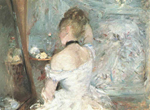
These Chasms in Continuity
"Spaces of complete immobility separated
each of these movements" (78).
Points for Reflection
V. Woolf's "An Unwritten Novel" (1920)
- What feature of others' bodies plays the most powerful role in shaping the narrator's imagination?
- How much of what the narrator describes about the woman sitting opposite is pure fancy, and how much roots itself in actuality?
- What physical impact does imitation have on the narrator when she, like her companion, tries to rub out a nearby spot on the train window?
- Why might “Minnie” avoid looking at the mirror in the guest room at her sister-in-law’s house?
- Does the narrator assign “Minnie” a religious faith in order to mock her, commiserate with her, or for some other reason?
- If “the detail matters nothing!” (109), as the narrator attests, then why does she continue to conjure likely details in her imagination? Which sort of details matter to her, and what does she consider extraneous?
- To whom does the following thought belong, the narrator or “Minnie”? “[E]verything has meaning” (110).
- Does this story uphold, or question, the value of human connection?
- Does “James” present “Minnie” with an opportunity for meaningful connection?
- Is life itself, from the narrator’s perspective, pleasant? Does she imagine it pleasant for “Minnie”?
- At what point does reality intrude, irrevocably, on the narrator’s musings?
- What is the narrator falling on her knees to worship in the story’s close?
V. Woolf's "A Woman's College from Outside" (1920; 1926)
- Is this story’s title misleading?
- How does this portrait of female university students compare with the representation of the young men of Cambridge in Jacob’s Room? (Woolf originally intended this vignette to appear in that novel.)
- What emotion dominates the late evening camaraderie of these women?
- Can we extrapolate a more meaningful relationship from the fugitive connection described between Angela and Alice?
- What is the “light at the end of the tunnel” (141) which so excites Angela Williams?
Jacob's Room (1922), chps 6-10
- REDUX: do Woolf's stylistic experiments recall any similar innovations in the visual arts--in painting, for instance?
- REDUX: is the narrator’s critique of Jacob’s arrogance and naïveté harsh and sarcastic, or gentle and forgiving (or something else altogether)?
- Woolf’s narrator identifies something “tragic” in the taut and staring face of Florinda when we first meet her (57). Does Woolf’s continued portrayal of this character indeed render her tragic?
- Why is Jacob so enamored of Greek literature on page fifty-nine?
- Does Florinda “have a mind”?
- What might be the “look” on Jacob’s face that Florinda dislikes (64), and can we determine what caused it?
- What is the problem weighing on Jacob that leads him to lie to Florinda and say he has a headache (64)?
- Why do you think Woolf inserts two pages on “little paper flowers,” visiting cards, and the like (65-66) right after the initial section on Jacob and Florinda (57-64)?
- Why include the brief encounter between Jacob and Clara which follows (70)? What narrative purpose does Clara’s reappearance serve?
- Why would it be “irrational” for Mrs. Flanders to cry out “my son” upon learning of his relationship with Florinda? [Kaylee F]
- What benefits and drawbacks does the narrator attach to letter-writing?
- At what point does the reader become sure of Florinda’s profession?
- Does the narrator reveal the narrator’s own age and sex?
- How does Jacob respond to seeing Florinda with another man?
- The narrator, while considering Jacob’s emotional reaction to learning about Florinda’s profession, feels what contrary emotions?
- Why might Woolf includes the bit about the “old man with the white beard,” and how is this passage connected to the paragraph preceding it concerning our unchartered passions (75-76)?
- What does the narrator mean by the observation that “beauty is almost always dumb” (76)? [Zoie D]
- Provide an answer to Woolf’s narrator’s question about what humanity is searching for as we look from face to face, and move from book to book . . . endlessly (77).
- Who generates the harsh assessments of Moll Pratt, Mrs. Hilda Thomas, and Lady Rocksbier (79), the narrator or Jacob?
- Look again at chapter nine, at what events open the chapter and what observations close it. Why did Woolf bound these particular pieces together into a single chapter? Given the fragmented nature of this narrative, she could have started and stopped the chapter at any number of junctures. Why collect these fragments?
- What is Jacob doing in chapter nine? Do you think his life typical of men of his age in this period?
- Does the narrator give the stamp of approval to Jacob’s now (presumably) habitual visitation of prostitutes (83)?
- Do any of the female characters to whom we’re introduced in chps. 6-10 evince greater agency (practical or imaginative) than those various secondary characters in chps. 1-5 who seem relatively imprisoned by circumstance?
- Does chp. 9 capture a distinctly modern view of early 20th-century England, or does it contain timeless, unchanging elements?
- Does the same voice comment on the beauty of women (92) and the beauty of men (93)?
- What does Jacob think of modern (post-18th century) novels?
- Why does Jacob “honour” Clara Durrant above all other women (98)?
- Whose perspective on Jacob is the reader supposed to trust
more, that of the (female) narrator who notes his pride and the gaps
in his knowledge, or that of the various women who obsess over Jacob?
Is the nature of the female
narrator's
own obsession (this tale is organized around Jacob, after all)
substantially
different
from that of these various female characters?

Lady at Her Toilette (1875)
Berthe Morisot
Dr. Paul Marchbanks
pmarchba@calpoly.edu
![]()
